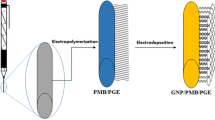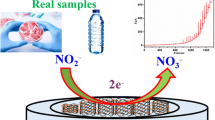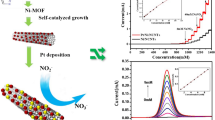Abstract
A [5,10,15,20-tetrakis (4-methoxyphenyl) porphyrinato] manganese (III)chloride (TMOPPMn(III)Cl)-modified gold electrode sensor was developed for the determination of nitrite in food samples. The developed sensor showed an excellent catalytic activity and stability for nitrite oxidation. Under optimized conditions, nitrite concentration as low as 2.9 × 10−9 M can be determined in various food samples using the developed sensor. Effect of common interfering ions have been investigated in simulated mixtures containing high levels of interfering ions and the sensor was found to be tolerant against these ions. The determination of nitrite in food samples such as chicken ham, sausage and pickled vegetables with the proposed sensor was in good agreement with those obtained by standard spectrophotometric method.
Similar content being viewed by others
Explore related subjects
Discover the latest articles, news and stories from top researchers in related subjects.Avoid common mistakes on your manuscript.
Introduction
Nitrite ion (NO2 −) is one of the active intermediate species in the nitrogen cycle and a useful indicator of equilibrium state of the oxidative and reductive pathways of the nitrogen cycle. It is a simple oxy-anion of nitrogen with a pK a of 3.2 at 20 °C (Braida and Ong 2000). Nitrites are both of environmental and biological importance. Nitrite is ubiquitous within environment, physiological systems, and commonly used in some food as preservatives (Badea et al. 2001; Casella and Gatta 2004). Nitrite is used in meat curing due to three functions; (a) antimicrobial action (as preservative), (b) gives characteristic flavour of cured meat and (c) gives characteristic pink colour to cured meat due to the formation of nitrosomyoglobin. Moreover, nitrite can be formed in the production of pickled vegetables because of the biodegradation of nitrate or other nitrogenous substances (Santos et al. 2009).
The health hazards caused by the build-up of high nitrite concentrations in food samples, considering their use as preservatives, are subjects under investigations (Aydin et al. 2005). Once NO2 − is taken by the human body, it combines with blood pigments to produce meta-haemoglobin in which oxygen is no longer available to the tissues. In addition, nitrite can also react with amines and amides in stomach to produce carcinogenic N-nitrosamines (Fann and Kaneine 1993; Mirvish 1995). Therefore, the quantitative determination of nitrite concentrations is of great importance, especially for food quality control.
Various analytical methods have been used to determine nitrite ions, such as spectrophotometry (Fox 1979), gas chromatography (Helmke and Duncan 2007), ion chromatography (Butt et al. 2001) and chemiluminescence (Arthur et al. 2007). However, these methods proved to have limitations with respect to specificity, sensitivity, simplicity and analysis time. Even with the Griess assay (Fox 1979), the widely used classical method for the determination of nitrite is highly sensitive and specific; it is often associated with drawbacks such as longer coupling time, use of carcinogenic reagents and large sample volumes. Electrochemical techniques provide useful alternatives as they follow simple, cheap and safe analyses.
Electrode modifications with deposition of various functional compounds have attracted much interest due to its potential application (Cardoso and Gushikem 2005; Caro et al. 2002). Electrodes modified by incorporating metalloporphyrins are prospecting candidates for various applications because they have excellent thermal, chemical, electrochemical and photochemical stability(Alves et al. 1992; Vijayanathan et al. 1993). Porphyrins have demonstrated good features as analytical sensors because they can electrocatalyze the electron-transfer reactions increasing the sensitivity of the electrode (Joseph and Girish Kumar 2010; Leena and Girish Kumar 2010). The coordinated metal, the peripheral substituents and the conformations of the macrocyclic skeleton influence the coordination and the related sensing properties of these compounds. In this context, a manganese(III) complex of a porphyrin, TMOPPMn(III)Cl (Fig.1), is used as an electrode modifier for the development of a sensor for nitrite in a gold electrode matrix.
Experimental
Apparatus
Voltammetric measurements were carried out with an Electrochemical analyzer (BAS Epsilon Bioanalytical System, USA) coupled to a PC. An electrochemical cell containing 10 ml of buffer solution with Ag/AgCl as reference electrode, a Pt wire as auxiliary electrode and the modified gold electrode (GE) as working electrode was used for all measurements. The pH measurements were carried out in a Metrohm pH meter.
Reagents
Doubly distilled water was used for preparing all aqueous solutions; using analytical grade reagent. Sodium nitrite (NaNO2), monosodium dihydogen phosphate (NaH2PO4), disodium hydrogen phosphate (Na2HPO4), zinc acetate (Zn(CH3CO2)2), manganese acetate. Tetrahydrate (Mn(CH3CO2)2⋅4H2O) were purchased from SD Fine Chemicals (Mumbai, India). Porphyrin and metalloporphyrin (TMOPPMn(III)Cl) were prepared as previously reported (Adler et al. 1967; Gaugham et al. 1975). Pyrrole and anisaldehyde were obtained from Sisco Research Laboratories Ltd (India) and purified prior to use. Nafion (5%) was purchased from Sigma Aldrich.
Standards and sample solutions
Standard stock solutions
A standard stock solution of (1 × 10−1 M) was prepared by dissolving sodium nitrite in double distilled water. Working standard solutions were obtained by dilution of the stock solution.
Sample preparation for electrochemical assay
Samples of chicken ham, sausages and pickled vegetables were purchased at local stores and were treated according to the literature (Santos et al. 2009). Briefly, food samples were treated with saturated borax solution and zinc acetate (5%) solution was added to precipitate proteins. The mixture was diluted with water and filtered. The resulting filtrate solution was refrigerated under 4 °C for further studies. The nitrite concentration in real samples was determined using differential pulse voltammetric (DPV) technique and compared with those obtained with the standard spectrophotometric method.
Fabrication and characterization of working electrode
Gold electrode (GE), acquired from BAS Epsilon Bioanalytical System (USA), was used for sensor fabrication. Prior to modification, the electrode surface was mechanically polished with alumina slurries, rinsed with double distilled water and ultrasonicated successively in ethanol and water for 3 min each. The electrode was subjected to an electrochemical cleaning with 0.05 M sulphuric acid, after which it was rinsed with water and allowed to air dry. Gold electrode was modified by dropping 3 μl of 2.5mg ml−1 of TMOPPMn(III)Cl solution onto the clean electrode surface and evaporating the solvent at room temperature. TMOPPMn(III)Cl solution was prepared by dissolving 2.5 mg of TMOPPMn(III)Cl in a mixture of 3 ml nafion and 2 ml ethanol.
Surface morphological observations of bare GE and TMOPPMn(III)Cl-modified GE (TMOPPMn(III)Cl/GE) were carried out by scanning electron microscopy (SEM). Comparison of SEM images of the bare GE and TMOPPMn(III)Cl/GE points to the effective modification of bare GE (Fig. 2a and b).
Surface area study
The microscopic areas of the bare GE and TMOPPMn(III)Cl/GE were obtained by cyclic voltammetry (Fig. 3a and b) using 1.0 × 10−3 M K3Fe(CN)6 as a redox probe containing 0.1 M KCl at different scan rates (Xu and Wang 2005). For a reversible process, the anodic peak current ip is linear to ν 1/2 as follows:
where ip refers to the anodic peak current, A the surface area of the electrode, C o concentration of K3Fe(CN)6 and ν the scan rate. For 1.0 × 10−3 M K3Fe(CN)6, the electron transfer n = 1, the diffusion coefficient D R = 7.60 × 10–6 cm2s−1. Thus, from the slope of ip vs ν 1/2 relation, the microscopic areas of TMOPPMn(III)Cl-modified GE was calculated to be 0.1968 cm−2, which was about three times greater than the bare GE (0.08249 cm−2).
Analytical Procedure
Proper amount of sodium nitrite solution was transferred into an electrochemical cell, which contained 10 ml of 0.1 M phosphate buffer solution, and then the three-electrode system was installed on the cell. The solution was de-aerated with nitrogen for 5 min. Differential pulse voltammograms were recorded between 0.0 and 1.0 V at a scan rate of 0.1 V s−1. Pulse amplitude of 50 mV, pulse period of 200 ms and pulse width of 50 ms were used. The potential step was 4 mV. The peak current for oxidation of nitrite at a potential of 0.690 V was measured.
Results and discussions
Electrocatalytic oxidation of nitrite on modified gold electrode
The electrochemical behaviour of nitrite at a TMOPPMn(III)Cl/GE has been investigated using DPV and square-wave voltammetry (SWV). Since the oxidation of nitrite occurs at a lower potential of 0.690 mV (0.043 mA) using DPV compared to SWV (0.740 mV, 0.039 mA) further studies are carried out using DPV technique. The voltammetric response of 1 × 10−3 M nitrite in 0.1 M phosphate buffer solution (pH 6) at (a) bare GE and (b) TMOPPMn(III)Cl/GE has been recorded (Fig.4). As can be seen from the figure, nitrite does not generate a voltammetric response on bare GE. On the other hand, TMOPPMn(III)Cl/GE exhibits a sharper oxidation peak at a potential of 0.690 mV. This result illustrates that the TMOPPMn(III)Cl could present a favourable activity towards the oxidation of nitrite, suggesting that TMOPPMn(III)Cl/GE will be an excellent sensor for nitrite determination.
Optimizing the experiment conditions
The conditions for sensor fabrication and determination of nitrite were optimized, which included amount of TMOPPMn(III)Cl, effect of buffer solution and influence of buffer pH.
Effect of the amount of TMOPPMn (III)Cl
The amount of TMOPPMn(III)Cl solution on gold electrode directly determines the thickness of TMOPPMn(III)Cl film. As the amount was increased from 1 to 3 μl of 2.5 mg ml−1 TMOPPMn(III)Cl, oxidation peak current greatly enhanced. The enhancement of current indicates that the number of catalytic sites increased with increase in the amount of TMOPPMn(III)Cl. Further increase in the volume of TMOPPMn(III)Cl, results in decrease of the peak current. This is because nafion is a kind of insulator (Yi et al. 2001), which blocks the electron transfer at higher concentrations. Hence, 3 μl of 2.5 mg ml−1 TMOPPMn(III)Cl was chosen for further analysis.
Effect of supporting electrolyte and pH
The influence of supporting electrolyte for nitrite determination was tested for different electrolytes of 0.1 M concentration (H2SO4, HCl, NaCl, KCl, NaOH, citrate and phosphate buffer). The best response was obtained with phosphate buffer solution and hence it was selected for further studies.
The effect of solution pH on the electrochemical response of nitrite was investigated in the pH range from 2.0 to 8.0 in 0.1 M phosphate buffer solution. Fig. 5 shows the effect of pH values on the oxidation peak current of 0.1 M nitrite. It can be seen that the maximal peak current appeared at pH 6.0. Therefore, pH 6.0 was chosen for further studies.
Effect of scan rate
The effect of scan rate on the oxidation peak current was studied by DPV. It was found that current density for oxidation of 1 × 10−3 M nitrite shows a linear relationship with scan rate in the range 100–400 mV s−1 (at 95% confidence interval, j p = 0.0253 + 0.0027√ν); where j p is the current density in milliamperes per square centimetre and ν is the scan rate with a good correlation (r 2 = 0.9998; Fig. 6a and b). The result demonstrates that the oxidation process of nitrite at TMOPPMn(III)Cl-modified gold electrode is controlled by the mass transport of nitrite ion from the bulk solution to the electrode surface.
Interferences
The selectivity and anti-interference ability of TMOPPMn (III) Cl/GE was tested by studying the effects of common interfering ions in the determination of nitrite. No obvious interference was seen in nitrite determination, on addition of 100-fold excess of Ca2+, Cu2+, K+, PO4 2−, CO3 2− and NO3 −. However, a 50-fold excess of ascorbic acid showed a noticeable interference in nitrite determination using TMOPPMn (III) Cl/GE sensor.
Analytical characteristics of the sensor
Under optimized conditions (0.1 M phosphate buffer solution of pH 6), differential pulse voltammetric studies for oxidation of nitrite was carried out at different concentrations (Fig.7a). The current densities calculated were plotted against various nitrite concentrations (Fig.7b), which gave a straight line [at 95% confidence interval, j p (mA) = 36.73 + 2458.06 C]; where j p is the current density in milliamperes per square centimetre and C is the concentration in molar with good correlation (r 2 = 0.9954). The proposed sensor showed a linear response range from 5 × 10−2 to 9 × 110−8 M nitrite with a limit of detection of 2.9 × 10−9 M. This indicates that the presence of nitrite in food samples with concentration as low as 2.9 × 10−9 M can be determined using the proposed sensor.
The analytical characteristics of TMOPPMn(III)Cl/GE sensor in comparison with those reported in the literature is summarized in Table. 1.
The relative standard deviation of the peak current, corresponding to the oxidation of 1 × 10−3 M nitrite, for five determinations was found to be 1.46%. The TMOPPMn(III)Cl-modified gold electrodes were found to have reserved 97% of their initial activity for more than 2 weeks. These results demonstrated the good reproducibility and stability of the proposed sensor.
Determination of nitrite in food samples
To confirm the validity and accuracy of the developed sensor, nitrite content in chicken sausage, chicken ham and pickled vegetables was determined. The concentration of nitrite in food samples was determined by standard-addition method. Each test was repeated five times. The obtained results are in good agreement with those of standard spectrophotometric method (Table. 2). The results indicate that the proposed electrochemical sensor is reliable for the determination of nitrite in real samples.
Conclusion
The electrocatalytic oxidation of nitrite on TMOPPMn(III)Cl-modified gold electrode sensor can be used as an effective method for the determination of nitrite. Optimization of the experimental conditions yield a detection limit and linear range for NO2 − much better than those reported in the literature. The developed sensor has high sensitivity, good stability, reproducibility and anti-interference ability. The sensor is also promising for nitrite determination in food samples and the results are consistent with those obtained with standard spectrophotometric method. The use of less toxic reagents in the proposed method makes it more advantageous over the standard method for nitrite determination based on carcinogenic reagents.
References
Braida W, Ong SK (2000) Water Air Soil Poll 118:13
Badea M, Amine A, Palleschi G, Moscone D, Volpe G, Curcilli A (2001) J Electroanal Chem 509:66
Casella IG, Gatta M (2004) J Electroanal Chem 568:183
Santos WJR, Lima PR, Tanaka AA, Tanaka SMCN, Kubota LR (2009) Food Chem 113:1206
Aydin A, Ercan O, Tascioglu S (2005) Talanta 66:1181
Fann CSB, Kaneine JB (1993) Vet Hum Toxicol 35:521
Mirvish SS (1995) Cancer lett 93:17
Fox JB (1979) Anal Chem 51:1493
Helmke SM, Duncan MD (2007) J Chromatogr B 851:83
Butt SB, Riaz M, Iqbal MZ (2001) Talanta 55:789
Arthur PHM, Shiva S, Gladwin MT (2007) J Chromatogr B 851:93
Cardoso WS, Gushikem Y (2005) J Electroanal Chem 583:300
Caro CA, Bedioui F, Zagal JH (2002) Electrochim Acta 47:1489
Alves MCM, Dodelet JP, Guay D, Ladouceur M, Tourillon G (1992) J Phys Chem 96:10898
Vijayanathan V, Venkatachalam S, Krishnamurthy VN (1993) Polymer 34:1095
Joseph R, Girish Kumar K (2010) Drug Test Anal 2:278
Leena R, Girish Kumar K (2010) Drug Test Anal 2:436
Adler AD, Longo FR, Finarelli JD, Goldmacher J, Assour J (1967) J Org Chem 32:476
Gaugham RK, Shriver DF, Boucher LJ (1975) Proc Natl Acad Sci U S A 72:433
Xu Q, Wang SF (2005) Microchim Acta 151:47
Yi H, Wu K, Hu S, Cui D (2001) Talanta 55:1205
Karyakin AA, Karyakina EE, Schmidt HL (1999) Electroanal 11:149
Lubert KH, Guttmann M, Beyer L (1999) J Electroanal Chem 462:174
Acknowledgement
One of the authors (D. Thomas) is grateful to the Council of Scientific and Industrial Research (CSIR), India for fellowship.
Author information
Authors and Affiliations
Corresponding author
Rights and permissions
About this article
Cite this article
Thomas, D., Rajith, L., Lonappan, L. et al. Sensitive determination of nitrite in food samples using voltammetric techniques. Food Anal. Methods 5, 752–758 (2012). https://doi.org/10.1007/s12161-011-9292-3
Received:
Accepted:
Published:
Issue Date:
DOI: https://doi.org/10.1007/s12161-011-9292-3











